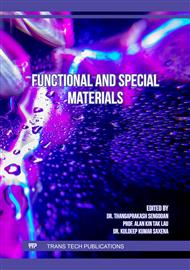[1]
H. Kleemann, G. Schwartz, S. Zott, M. Baumann, M. Furno, Flex. Print. Electron. 5 (2020) 14009.
Google Scholar
[2]
M. Mushrush, A. Facchetti, M. Lefenfeld, H.E. Katz, T.J. Marks, J. Am. Chem. Soc. 125 (2003) 9414–9423.
DOI: 10.1021/ja035143a
Google Scholar
[3]
S.G. Kim, J. Jun, J.S. Lee, J. Jang, J. Mater. Chem. A 7 (2019) 8451–8459.
Google Scholar
[4]
T. Minami, Y. Sasaki, T. Minamiki, P. Koutnik, P. Anzenbacher, S. Tokito, Chem. Commun. 51 (2015) 17666–17668.
DOI: 10.1039/c5cc07893h
Google Scholar
[5]
S.P. Tiwari, K.A. Knauer, A. Dindar, B. Kippelen, Org. Electron. 13 (2012) 18–22.
Google Scholar
[6]
S. Mijalković, D. Green, A. Nejim, G. Whiting, A. Rankov, E. Smith, J. Halls, C. Murphy, "2008 26th Int. Conf. Microelectron. Proceedings, MIEL 2008" (2008) 469–476.
DOI: 10.1109/icmel.2008.4559324
Google Scholar
[7]
K. Joardar, K.K. Gullapalli, C.C. McAndrew, M.E. Burnham, A. Wild, IEEE Trans. Electron Devices 45 (1998) 134–148.
DOI: 10.1109/16.658823
Google Scholar
[8]
M. Estrada, A. Cerdeira, J. Puigdollers, L. Reséndiz, J. Pallares, L.F. Marsal, C. Voz, B. Iñiguez, Solid. State. Electron. 49 (2005) 1009–1016.
DOI: 10.1016/j.sse.2005.02.004
Google Scholar
[9]
C.H. Kim, Y. Bonnassieux, G. Horowitz, IEEE Trans. Electron Devices 61 (2013) 278–287.
Google Scholar
[10]
T. Sakurai, B. Lin, A.R. Newton, IEEE Trans. Comput. Des. Integr. Circuits Syst. 11 (1992) 228–234.
Google Scholar
[11]
Y.H. Hu, S. Pan, IEEE Trans. Comput. Des. Integr. Circuits Syst. 12 (1993) 1481–1487.
Google Scholar
[12]
T. Bendib, F. Djeffal, IEEE Trans. Electron Devices 58 (2011) 3743–3750.
Google Scholar
[13]
F. Djeffal, T. Bendib, Microelectronics J. 42 (2011) 661–666.
Google Scholar
[14]
T. Bendib, F. Djeffal, D. Arar, J. Comput. Electron. 10 (2011) 210–215.
Google Scholar
[15]
S. Ono, N. Minder, Z. Chen, A. Facchetti, A.F. Morpurgo, Appl. Phys. Lett. 97 (2010) 95–98.
Google Scholar
[16]
C. Tanase, E.J. Meijer, P.W.M. Blom, D.M. de Leeuw, Phys. Rev. Lett. 91 (2003) 1–4.
Google Scholar
[17]
M.J. Panzer, C.D. Frisbie, J. Am. Chem. Soc. 129 (2007) 6599–6607.
Google Scholar
[18]
Y. Xia, J.H. Cho, J. Lee, P.P. Ruden, C.D. Frisbie, Adv. Mater. 21 (2009) 2174–2179.
Google Scholar
[19]
S. Zhang, N. Sun, X. He, X. Lu, X. Zhang, J. Phys. Chem. Ref. Data 35 (2006) 1475–1517.
Google Scholar
[20]
V.O. Turin, A. V. Sedov, G.I. Zebrev, B. Iñiguez, M.S. Shur, Int. Conf. Micro- Nano-Electronics 2009 7521 (2009) 480–488.
Google Scholar
[21]
B. Iñiguez, R. Picos, D. Veksler, A. Koudymov, M.S. Shur, T. Ytterdal, W. Jackson, Solid. State. Electron. 52 (2008) 400–405.
DOI: 10.1016/j.sse.2007.10.027
Google Scholar
[22]
M. Shur, M. Hack, J. Appl. Phys. 55 (1984) 3831–3842.
Google Scholar
[23]
A. Cerdeira, M. Estrada, R. Garcı́a, A. Ortiz-Conde, F.J. Garcı́a Sánchez, Solid. State. Electron. 45 (2001) 1077–1080.
DOI: 10.1016/s0038-1101(01)00143-5
Google Scholar
[24]
I. Benacer, Z. Dibi, Int. J. Autom. Comput. 13 (2016) 382–391.
Google Scholar
[25]
A. Rolland, J. Richard, J.P. Kleider, D. Mencaraglia, J. Electrochem. Soc. 140 (1993) 3679–3683.
Google Scholar
[26]
J.H. Holland, others, Adaptation in Natural and Artificial Systems: An Introductory Analysis with Applications to Biology, Control, and Artificial Intelligence, MIT press, 1992.
DOI: 10.7551/mitpress/1090.001.0001
Google Scholar
[27]
N. Akkan, M. Altun, H. Sedef, IEEE Access 7 (2019) 180438–180450.
DOI: 10.1109/access.2019.2959474
Google Scholar
[28]
L. Kergoat, L. Herlogsson, D. Braga, B. Piro, M.C. Pham, X. Crispin, M. Berggren, G. Horowitz, Adv. Mater. 22 (2010) 2565–2569.
DOI: 10.1002/adma.200904163
Google Scholar
[29]
Y. Yadav, S.K. Ghosh, S.P. Singh, ACS Appl. Electron. Mater. 3 (2021) 1496–1504.
Google Scholar
[30]
S.M. Sze, Y. Li, K.K. Ng, Physics of Semiconductor Devices, John wiley \& sons, 2021.
Google Scholar



